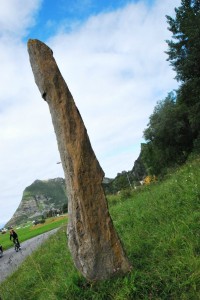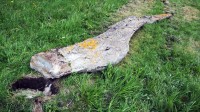 Northern Norway’s tallest stone monolith was knocked down and broken into three pieces by a grass edger last month. The stone had stood in a field on the island of Engeløya in the municipality of Steigen for more than 1,000 years, towering 10 feet above the ground. Its exact date is unknown, but burials found at the site of other phallic stones date them to the Scandinavian Iron Age, 200-600 A.D., significantly before the Viking era.
Northern Norway’s tallest stone monolith was knocked down and broken into three pieces by a grass edger last month. The stone had stood in a field on the island of Engeløya in the municipality of Steigen for more than 1,000 years, towering 10 feet above the ground. Its exact date is unknown, but burials found at the site of other phallic stones date them to the Scandinavian Iron Age, 200-600 A.D., significantly before the Viking era.
Located 550 yards south of the picturesque 13th century Steigen Church, it marked the boundary line between two of the village’s biggest farms, Laskestad and Steig, although it long predates the existence of both farms. It may have been a grave marker originally, local legend says to an ancient king. It’s one of the area’s top tourist attractions and claims to fame.
Now its great height is halved and prostrate on the grass, while its stump alone is still vertical, buried in a hole, the glacier blue of the stone’s interior, once modestly covered by grey weathering and yellow lichen, lies exposed in the open wound. The subcontractor hired to cut the grass near the roadside where the monolith stood bumped into the stone and it broke at the base. He told the mayor that the stone was so delicate even the vibration of the edger was almost sufficient to topple it.
 Obviously it was an accident, not a deliberate act of vandalism, but the longstone is a protected monument and damaging it is a violation of Norway’s Cultural Heritage Act. The stone was specifically described in the contract, however, so there’s a negligence element here. Mesta AS, the state-owned construction and civil engineering company who employed the subcontractor, is now in the legal cross-hairs. Egil Murud, culture protection chief of Nordland county, announced Wednesday that her office has written a report to be delivered Thursday, July 17th. Mesta AS will have to account for itself in court.
Obviously it was an accident, not a deliberate act of vandalism, but the longstone is a protected monument and damaging it is a violation of Norway’s Cultural Heritage Act. The stone was specifically described in the contract, however, so there’s a negligence element here. Mesta AS, the state-owned construction and civil engineering company who employed the subcontractor, is now in the legal cross-hairs. Egil Murud, culture protection chief of Nordland county, announced Wednesday that her office has written a report to be delivered Thursday, July 17th. Mesta AS will have to account for itself in court.
Meanwhile, archaeologists and conservators from the Tromsø University Museum have documented the broken pieces and wrapped them to contain any chipping. The question of what to do next is still open. Theoretically it is possible to join the sections by drilling holes in the stone and inserting stainless steel bolts into them. It’s a very invasive solution, however, and the stone is quite thin compared to its height and it’s very heavy, so the bolts may not even work. Other options are being considered, including creating a copy to stand in the original location while the pieces are moved to the Steigen village square where they would lie flat, or putting the pieces on display at the Tromsø Museum.
Mustn’t this be 200-600 BC ?
So Norway’s going to sue itself. It’s unclear from all that’s written that the offender was a hand held edger or or a riding machine. The obvious job specs should have been no heavy (wheeled or tracked) machinery within so many feet with the rest done by hand. The Subber is trying to state his case on the fragility of the stone was not recognized by authorities who issued and oversaw his contract even though he warned of this possibility ahead of his work. He may be right, hard to say with the evidence.
In putting Humpty Dumpty back together again you have multiple problems I’m sure the author and readers are familiar with. From my background I can think of a few possibilities, but they all hinge on the longevity vs appearance problem.
I wonder if it would be possible to make some kind of transparent brackets to hold the pieces together? I think original stone should stay in place and not its copy. If it is impossible to use custom made brackets, the stone could be placed horizontally in a glass case near its original location. This way people will see its full size, including the part that was buried in soil.
Tragic! No one has any respect for anything anymore! This is how civilizations die! They just self-destruct with their own internal neglect!
By the telltale path visible from the machine…one can see that he ran straight into it.
Not to be a joker but the answer is probably stone adhesive. A jig would have to be made to hold it all together while the adhesive set-up. We are not talking Elmers glue but the stuff we glue machinery back together with, I’ve glued landscape stone together with manonary glue that is stronger than the stone. The pin idea seems like last resort type action. Do no harm, is the first order of the day, when fixing things.
“Now its great height is halved and prostrate on the grass, while its stump alone is still vertical, buried in a hole…”
I see what you did there. Kudos. 😉